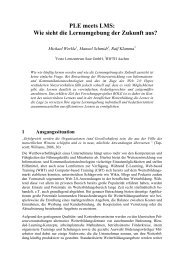Customized PLE implementations for test-bed scenario ... - ROLE
Customized PLE implementations for test-bed scenario ... - ROLE
Customized PLE implementations for test-bed scenario ... - ROLE
Create successful ePaper yourself
Turn your PDF publications into a flip-book with our unique Google optimized e-Paper software.
technology support assessment? If yes, describe in brief how technology<br />
supports assessment. How is the assessment outcome used <strong>for</strong> which<br />
purposes?<br />
• Are activities and skills (domain-specific, tool-specific, SRL-specific) modelled<br />
and assessed? How are domain-specific activities and skills modelled and<br />
assessed? How are tool-specific activities and skills modelled and assessed? Is<br />
there a learner profile in electronic <strong>for</strong>m which includes learning goals (to-be<br />
states) and skill/competence development over time (current states)?<br />
• Who per<strong>for</strong>ms the planning <strong>for</strong> learning and who defines the expected outcome<br />
(learning goals)? Is this done <strong>for</strong>mally and explicitly?<br />
• Which of these five aspects (SRL, guidance, recommendations, monitoring and<br />
assessment, activities and skill profiles / none / other) are planned to be<br />
addressed in the future? Where are the restrictions concerning these points in<br />
the <strong>test</strong>-<strong>bed</strong>? Where are the restrictions concerning these points (SRL, guidance,<br />
recommendations, monitoring and assessment, activities and skill profiles) in the<br />
<strong>test</strong>-<strong>bed</strong>? Add more in<strong>for</strong>mation, if available.<br />
• Which kinds of training and learning materials are available in the <strong>test</strong>-<strong>bed</strong>? Are<br />
these materials customizable according to individual needs of learners? Describe<br />
how! Is the learning material modelled, in order to be used by services (e.g. to be<br />
recommended)? Describe in brief, how the learning material is modelled in order<br />
to be used by services (e.g. to be recommended).<br />
2.3 The community perspective (RO3, RO4)<br />
In contrary to the PPIM, work package 7 aims at developing a bottom-up approach<br />
based on good practices in communities.<br />
Model and methodology <strong>for</strong> <strong>PLE</strong>-based collaboration in learning ecologies<br />
Based on <strong>PLE</strong> literature and an in-depth analysis of the five <strong>test</strong>-<strong>bed</strong>s, the deliverable<br />
D7.1/ID7.2 (‘Model and Methodology <strong>for</strong> <strong>PLE</strong>-Based Collaboration in Learning<br />
Ecologies’) introduces a theoretical model of <strong>PLE</strong>-based learning ecologies in which<br />
<strong>PLE</strong> users (actors) interact with entities like artefacts, media (collections of artefacts),<br />
processes (activities), other agents (peers or computer programs), and communities<br />
(see also left-hand side of Figure 2-2). The learners are involved in different activities in<br />
which they use their learning environments (i.e. specific tools or tool combinations) to<br />
connect to learner networks and collaborate on shared artefacts in order to achieve<br />
personal or group goals (see right-hand side of Figure 2-2).<br />
Page 12 of 102



